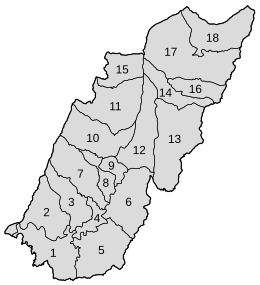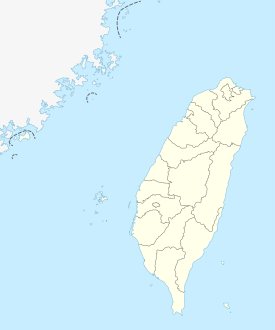Neimen (Kaohsiung)
|
Neimen 內 門 區 |
||
 Location of Neimen District in Kaohsiung |
||
| State : |
|
|
| Coordinates : | 22 ° 57 ′ N , 120 ° 28 ′ E | |
| Area : | 95.6224 km² | |
| Residents : | 14,280 (July 2019) | |
| Population density : | 149 inhabitants per km² | |
| Time zone : | UTC + 8 (Chungyuan time) | |
| Telephone code : | (+886) (0) 7 | |
| Postal code : | 845 | |
| ISO 3166-2 : | TW-KHH | |
| Community type : | Municipality of Kaohsiung | |
| Structure : | 18 districts (里) | |
| Website : | ||
|
|
||
Neimen ( Chinese 內 門 區 , Pinyin Nèimén Qū ) is a municipality of Kaohsiung in the Republic of China (Taiwan) .
Location description
Neimen is located in the northeast of the urban area of Kaohsiung on the border with the urban area of Tainan . The adjacent boroughs are Shanlin in the northeast, Qishan in the east, Tianliao in the south and the three Tainan boroughs Longqi , Zuozhen and Nanhua in the west.
The Neimens area has an elongated shape and extends for about 17 km from south-southwest to north-northeast with a transverse extent of about 5 to 7 kilometers. This is where the Erren River rises , which flows westwards and later forms the border between Tainan and Kaohsiung over a longer section.
history
An older name of Neimen is Luohanmen ( 羅漢 門 ). There are two theories about the origin of the name. On the one hand, it is said to have originated as a transliteration of the place name Rohan from Makatao , a variant of the Siraya language that was spoken by the local Austronesian indigenous population . Rohanmen or Luohanmen was thus the "gateway to Rohan" ( 門 , Mén - "gate"). On the other hand, it is said to have referred to the mountains on both sides of the Erren River, which were reminiscent of two Arhats (Chinese: Luohan ) who guarded the Erren river valley as a kind of entrance gate to the plains further west. From the 17th century onwards, the indigenous people were gradually Sinised by the Han Chinese immigrants who had come to the island from the mainland , or pushed into the mountains to the east. With the further penetration of the Han settlers inland, the area west of the small rivers or streams Erren and Nanxixian Erxi ( 楠梓 仙 二 溪 ) became the “inner gate” ( 內 門 , Nèimén ), while the area further east ( the eastern part of Neimens and today's Qishan) was the "outer gate" ( 外 門 , Wàimén ).
In 1721 Neimen was one of the starting points for the first major rebellion against the Qing rule. Under the leadership of the "duck emperor" ( 鴨 母 皇帝 , Yāmǔ Huángdì ) Zhu Yigui ( 朱一貴 , Zhū Yīguì ), a poultry farmer from Neimen, the rebels were even able to take the prefecture capital Tainan, where Zhu Yigui proclaimed himself ruler of Taiwan. His rule lasted only two months, the uprising was suppressed, and Zhu Yigui was captured and executed.
At the time of Japanese rule in Taiwan (1895-1945) the area was organized as the village of Neimen ( 內 門 庄 , Nèimén Zhuāng , Japanese. Uchikado Shō ). After the Republic of China took over Taiwan in 1953, this resulted in the rural community of Neimen ( 內 門 鄉 , Nèimén Xiang ) in the newly established Kaohsiung district . After the incorporation of the entire district into the city of Kaohsiung on December 25, 2010, Neimen received the status of a city district ( 區 , Qū ).
population
At the end of 2017, 61 people belonged to the indigenous peoples of Taiwan (approx. 0.4%). Hakka's share was well below 5%.
| Outline Neimens |

|
Administrative division
Neimen is further subdivided into 18 districts (里, Li ):
1 Ruishan ( 瑞 山里 )
2 Neidong ( 內 東 里 )
3 Zhongpu ( 中 埔里 )
4 Guanting ( 觀 亭 里 )
5 Neinan ( 內 南 里 )
6 Dongpu ( 東 埔里 )
7 Guangxing ( 光 興 里 )
8 Neili ( 內 豊 里 )
9 Neimen ( 內 門 里 )
10 Sanping ( 三 平 里 )
11 Muzha ( 木柵 里 )
12 Shikeng ( 石 坑里 )
13 Yongfu ( 永富 里 )
14 Yongji ( 永吉 里 )
15 Neixing ( 內 興 里 )
16 Yongxing ( 永興 里 )
17 Gouping ( 溝 坪 里 )
18 Jinzhu ( 金 竹 里 )
economy
Agriculture is the main line of business alongside tourism. The soils of Neimen are not very productive and the region is not well suited for growing rice due to the hilly topography. Are grown Flamingo Flower (about 1/3 of Taiwanese total production), Cynanchum boudieri ( 薄葉牛皮消 , Baoye niupi Xiao - "Dünnblättriges cowhide" or 萬能薯 , Wànnéng shǔ - "Universal potato", etc.), a cassava -like root vegetables or a medicinal plant of Chinese medicine (on about 40 ha), pineapple (about 80 ha), guava (about 60 ha), longan , etc. a. m. Bamboo products are also produced, e.g. B. Baskets for banana exports from neighboring Qishan.
traffic
The most important traffic artery is Provincial Road 3, which comes from the southeast to Neimen and leads in a relatively straight line to the north, towards Nanhua. County road 182 branches off in the south and runs in a westerly direction.
Landmarks, tourism
Neimen is probably best known from a tourist point of view through the annual Songjiang Festival ( 宋江 陣 , Sòngjiāng zhèn , English Song Jiang (Battle) Array ), a folklore performance that combines ancient Chinese martial arts and artistic representations. In imaginative costumes and equipped with dummy weapons, groups of actors demonstrate symbolically and theatrically old battle arrangements and combat operations. The performing groups come from all over Taiwan, but the local residents also take part intensively. The first such performance took place in 1993 and since 2001 it has been part of the Kaohsiung cultural program.
The height 308 (308 高地 , 308 Gāodì , ), is a small, 308 meter high hill in the border region to neighboring Zuozhen , which is the highest elevation in the area and from which one has wide views over the mountains.
![]()
According to tradition, seven meteorites once fell on the area of Neimen, from which seven hills were formed. A small monument has been erected on each of the hills that are considered to have spiritual significance. The arrangement of the seven hills is said to correspond to the stars of the Big Dipper constellation and the hills have been given appropriate names.
In the Mother Duck Zhu Yigui Cultural Park ( 鴨 母 寮 朱一貴 文化 園區 , Yāmǔliáo Zhū Yīguì wénhuà yuánqū , ) a memorial commemorates the Zhu Yigui uprising.
![]()
The Guanyin - Buddhism has in the district many followers and there are three more important temples: the Zizhu Temple ( 紫竹寺 , Zǐzhú Sì , ) in the district of Guanting, the Shunxian Temple ( 順賢宮 , gōng Shùnxián , ) in the district Shigou, and the Nanhai Zizhou Temple ( 南海 紫竹 寺 , Nánhǎi zǐzhú sì , ). The “Greeting of the Buddha at the Gate of the Arhats” ( 羅漢 門 迎 佛祖 , Luóhànmén yíng fózǔ ), an annual procession through Neimen, has been declared a national cultural heritage by the Taiwanese Ministry of Culture.
![]()
![]()
![]()
South of the Zizhu Temple, the 195 meter long Guangming Bridge ( 光明 橋 , Guāngmíng qiáo , ), a pedestrian suspension bridge over the Erren, completed in 2007, connects Zizhu Park ( 紫竹 公園 ) with Zizhuminsu Park ( 紫竹民俗 公園 ).
![]()
Web links
Individual evidence
- ↑ a b c 展 高雄 ("Kaohsiung Exhibition"). Retrieved September 7, 2019 (Chinese (traditional), online exhibition on various city districts).
- ↑ Han Cheung: Taiwan in Time: The antirebels of the Qing era. Taipei Times, April 28, 2019, accessed September 8, 2019 .
- ^ Gary Marvin Davison: A short history of Taiwan: The Case for Independence . Praeger, Westport , London, ISBN 0-275-98131-2 , pp. 32-33 (English).
- ↑ 地理位置 ("Geographical Location"). Neimen website, September 2, 2019, accessed September 7, 2019 (Chinese (traditional)).
- ↑ 原住民 戶數 及 人數 Households and Persons of Indigenous People. (xls) Taiwan Ministry of the Interior, accessed August 4, 2018 (Chinese, English).
- ↑ 楊文 山 (Yang Wenshan): 全國 客家 人口 基礎 資料 調查 研究 ("Basic data survey on the national Hakka population") . 2004, ISBN 957-01-9320-4 , Appendix: 鄉鎮 市區 臺灣 客家 人口 數 及 比例 (“Number and Proportion of the Taiwanese Hakka Population in Towns and Cities”) - (Chinese (traditional), online ).
- ↑ 30. Cynanchum boudieri H. Léveillé & Vaniot, Bull. Soc. Bot. France. 51: 144. 1904. 折 冠 牛皮 消 . In: Flora of China . tape 16 , p. 216 (English, online ).
- ↑ 地方 特產 ("Local specialties"). Neimen website, September 2, 2019, accessed September 8, 2019 (Chinese (traditional)).
- ^ Song Jiang Battle Array, Neimen. taiwangods.com (Ministry of Interior of Taiwan), September 9, 2019, accessed September 7, 2019 .
- ^ Nancy Liu: Battle royale. Taipei Times, March 28, 2013, accessed September 7, 2019 .
- ^ A b Neimen District Turning Badlands into Modern Legend. udn.com, April 17, 2018, accessed September 7, 2019 .
- ↑ An ancient Chinese tradition made modern: Taiwan's 2019 Kaohsiung Neimen Song Jiang Battle Array. Taiwan Scene, April 19, 2019, accessed September 7, 2019 .
- ↑ George Liao: The 2019 Kaohsiung Neimen Song Jiang Battle Array to culminate on April 6. Taiwan News, March 31, 2019, accessed September 7, 2019 .
- ↑ KAOHSIUNG Neimen SONGJIANG BATTLE ritual (高雄 內 門 宋江 陣). YouTube video, accessed September 8, 2019 .
- ↑ 308 高地 ("Height 308"). Neimen website, September 2, 2019, accessed September 7, 2019 (Chinese (traditional)).
- ↑ 七星 墜地 ("7 falling stars"). Neimen website, September 2, 2019, accessed September 7, 2019 (Chinese (traditional)).
- ↑ 鴨 母 祠 朱一貴. Neimen website, September 2, 2019, accessed September 7, 2019 (Chinese (traditional)).
- ↑ Shunxian Gong (Temple), Neimen. taiwangods.com (Ministry of Interior of Taiwan), September 9, 2019, accessed September 7, 2019 .
- ↑ Kaohsiung's Buddha tour receives certification. Taiwan Ministry of Culture, April 2, 2015, accessed September 7, 2019 .
- ↑ 光明 橋 ("Guangming Bridge"). Neimen website, September 2, 2019, accessed September 7, 2019 (Chinese (traditional)).




